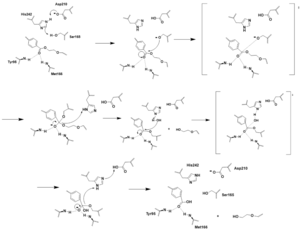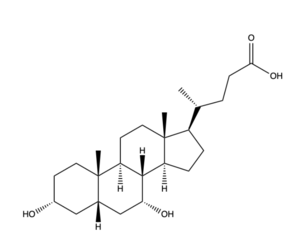Sandbox Reserved 1784
From Proteopedia
(Difference between revisions)
| Line 25: | Line 25: | ||
== Significance == | == Significance == | ||
| - | NTCP serves a multitude of biological functions, including bile salt uptake and HBV/HDV binding. | + | NTCP serves a multitude of biological functions, including bile salt uptake and HBV/HDV binding. NTCP is a key player in the absorption and digestion of fats and fat-soluble vitamins in the body. The uptake of bile salts, transcriptional and post-transcriptional, are signaling molecules for the liver and intestine. |
=== Bile Salt Uptake === | === Bile Salt Uptake === | ||
[[Image:Bile Salt structure.png|300 px|left|thumb|'''Figure 2.''' Bile Salt Structure.]] | [[Image:Bile Salt structure.png|300 px|left|thumb|'''Figure 2.''' Bile Salt Structure.]] | ||
| + | |||
| + | Disease of the liver is due to a decrease in bile salt uptake. This disease is transferred through bodily fluids between organisms. Liver Disease causes symptoms such as jaundice, abdominal pain and swelling, and swelling of the legs and feet. Liver disease can lead to liver cancer and other life-threatening diseases, making bile salt uptake essential to liver function. | ||
=== HBV/HDV === | === HBV/HDV === | ||
Revision as of 19:48, 20 March 2023
| This Sandbox is Reserved from February 27 through August 31, 2023 for use in the course CH462 Biochemistry II taught by R. Jeremy Johnson at the Butler University, Indianapolis, USA. This reservation includes Sandbox Reserved 1765 through Sandbox Reserved 1795. |
To get started:
More help: Help:Editing |
Sodium Taurocholate Co-Transporting Polypeptide
| |||||||||||
References
- ↑ Hanson, R. M., Prilusky, J., Renjian, Z., Nakane, T. and Sussman, J. L. (2013), JSmol and the Next-Generation Web-Based Representation of 3D Molecular Structure as Applied to Proteopedia. Isr. J. Chem., 53:207-216. doi:http://dx.doi.org/10.1002/ijch.201300024
- ↑ Herraez A. Biomolecules in the computer: Jmol to the rescue. Biochem Mol Biol Educ. 2006 Jul;34(4):255-61. doi: 10.1002/bmb.2006.494034042644. PMID:21638687 doi:10.1002/bmb.2006.494034042644


